|
|
||||
| IaN+.
Spacing the "Horizon" Charles Batach |
||||
| [in italiano] | Where does the sky begin? The sky begins there. Just on the edge of my ceiling Corinne Mercadier, photographer, at the Gallery Isabelle Bongard. |
[18jul2001] | ||
 Since its formation in 1996 the International architect Network or more likely IaN+ proposed architecture work that dealt with Architecture as a way of life, a way of being in time and space. In this article I will give interest to different components that reflect their thinking, and form their work in general, in order to expose then the "Horizon" project: their latest proposal for the Parking lot competition at Via Salaria, in Rome. Architecture as a way of life is not a slogan that IaN+ launched but a realty that they elaborate in every project by Spacing. Operative strategies like: Mapping, Updating Programs and Spatial Weaving are the components that form this concept of Spacing. Mapping is an operation that does not consist in designing a new map as much as it consists in operating inside an existing map, any possible map, in order to generate lines or to deal with existing lines. Mapping rises the question of ground and surroundings into IaN+ work. it questioned the nature of space that the ground could play at the urban level. Mapping operates on the ground by field and range. In fact, a project for IaN+ is not the object in the site but rather it is the field of relations that they intend to inject in the context. A field of relation that has a certain range to include the surrounding of their intervention. |
||||
|
Operating inside an existing map imply dealing with an existing program that the map contain. IaN+ 's work operate by updating the existing program to generate an infrastructure that could stimulate the field of relations and calibrate its range in the surrounding. In fact it is capable of relating itself with the different activities of the surrounding and can generate by itself a multiplicity of activities. It is in that way that the urban space tend to evolve inside the existing map by drawing other lines. Updating programs rises the issue of activity in architecture that is possible to take place on the ground and in space and time . It deals with this notion through forming an infrastructure using a multiplicity of component in order to weave other spaces. |
||||
 
|
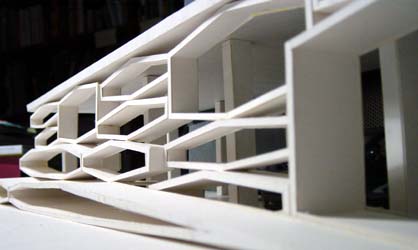 Spatial Weaving is an operation where all possible relations tends to coexist to form a space, another space and other spaces. The lines that IaN+ weave, relate together all existing and intended relations to form a space. Through weaving IaN+ search to form a continuum tissue of space. In fact space is seen as a tissue of relation in the air. It relates all possible relations together and with each other in order to have spatial continuity and a fluidity. In spatial weaving, IaN+ use what John Rajkman, in his book Constructions, qualified "Other geometry". It is an idea supported by the late philosopher Gilles Deleuze when he says that every person has its own geometry and generates its own lines. This kind of thinking was used before by Bruce Lee in a different field like: martial arts. For Bruce lee Martial art represented a way of life. He always said that he was a martial artist first and an actor second. In his work "the Jeet Kune do" (the way of the intercepting fist) he did not stop at representing movement on a paper but he applied geometry to the human body in order to study how to generate his own lines in space. Bruce lee understood that power fighting was not as a matter of strength and muscle as much as it was a matter of movement. |
IaN+. After various joint projects with major agencies in Europe and the United States (Fuksas, Eisenman...), architects Carmelo Baglivo and Luca Galofaro and engineer Stefania Manna set up the IaN+ studio in 1997. This multy-disciplinary agency is aimed at being a place where the theory and practice of architecture overlap and meet. IaN+’s areas of activity are conducted on various scales-interior architecture, institutional projects, and urban and territorial projects. In each instance, through architecture, their projects explicitly question the contemporary urban condition. Construction and building, seen as an open and variable arena, must usher in a permanently repeated encounter between subject and program. IaN+’s archtitecture is thus conceived as a method endowed with independence, like a perpetual updating of a programmatic and topological diagram. In tandem with their design production, the IaN+ architects are also involved in the teaching, publication and exhibition of architecture. |
||

|
Controlling the movement imply generating lines in space that are capable of re-dimensioning the force of the fighter to confront the opponent, the other. A possible situation was the exercise on the wood mannequin where Bruce Lee used to experiment for hours different possibilities of confrontation with the other, seen as a possible world as Deleuze puts it. The wood mannequin represented for him the field of experience. Another form of exercise was fighting the shadow where his movement is performed with space and projected by his shadow. His shadow becomes a sort of another existence, that grow to dimension itself in function of his movement. It is the lines and directions drawn in space that helps generating other dimensions. Ian+ uses other geometry not to shape new forms by the lines drawn but mainly to conceive a field of experience, a space that its dimension is experimental because its capable of generating itself over and over through movement. In weaving IaN+ tends to intensifying and densifying the possibilities of drawing such lines that can auto-generate dimension through dimension. This is how space become a field of experiment for life and not simply a container for a living. |
|||
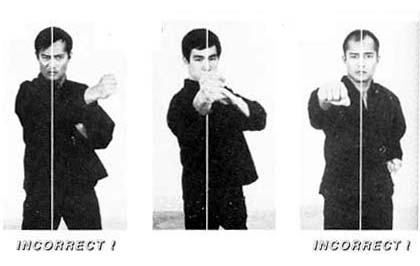 Mapping, updating programs, and spatial weaving are operative strategies or component that IaN+ use in their concept of spacing, of forming a project. Those components do not work without each others. They operate together and with in each other. They cannot be separated when they tend to form a project, a way of living. A possible project, that they form is the "Horizon" project which is the proposal presented by IaN+ for the competition of the parking lot in via Salaria, Rome. "Horizon" is not seen as the limit where things end or cease to exist as much as it is seen as a line on which things start to take other dimensions. "Horizon" is seen as a line of mediation between dimensions. Following this vision IaN+ tried spacing this line of mediation: Spacing the Horizon. In this second half of this essay, I will try to explain how the concept of spacing was applied and how his components tended to realize a project with a similar aim. The existing map of the area presented particular conditions: the ground to build on is a green land located between the tow hills of "Prati Fiscali" and circondated by the lines of the city with its growing tissues from one side and by the Railways lines from the other side. |
||||
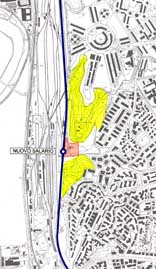 |
The area was crossed by an existing road that relates the city lines and the railways lines with each other. IaN+ decided to work on these existing conditions in order to valorize their potential. They located their infrastructure in a way that allowed them to save the green of the ground from being divided and from losing its role as a public space. They maintain it as a field to work on with a range that operates on the city movement and on the railway station. Located between the tow hills "Horizon" forms a continuum skyline with them. From east "Horizon" comes in contact with the road so that it intercepts the city movements liberating the front of the park from the circulation. From west it relates itself with the railway station in a direct way without creating new divisions in the green-land. It is fair to say that by mapping IaN+ intercepted the existing movement in the area and decided to place their infrastructure in its possible wave. The choice was a kind of an "insertion in an existing wave" as Deleuze puts it. In updating the program IaN+ were concerned mostly of the role that "Horizon" should offer to the city-life. The Arrivals to the station and the departure from it are tow essentials points to treat. But the event to consider was the line in between the points. In fact, the event in "Horizon" consists in its role of mediation from the arrival point to the departure point. It is a mediation between the different speeds involved, from a dimension to another: from the road line to the railway lines. IaN+ were also interested in developing the green land to increase its role so that it becomes more active in the city life. In order to do that they programmed their infrastructure to operate as an Interface between the tow ambient so they can establish an exchange between them. The idea of Interface was theorized by Paul Virilio in his Book "The Critical space" where he states that every surface could be interpreted as "an interface between tow ambient where it exists a constant activity in form of exchange between the tow substances in contact". |
|||
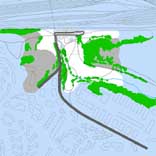 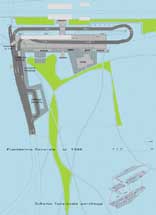
|
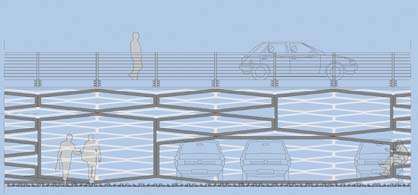  IaN+ aimed to realize that by including a multiplicity of functions: a 410 parking places for cars, 30 parking spaces for motorcycles, a bus stop and a variety of shops and different places to play, to socialize and to spend time so that would also help promoting the green as a future park for the city.  In weaving "Horizon" IaN+ tended to develop the notion of interface by transparency and by Movement. The transparency is due to the Screen that Ian+ wove on both side of the Parking places. the screen is made mostly of the void. the line that are waved are more like a contour for the spatial tissue that allow different relations to float. Relying on the movement traced by the flux of the city IaN+ tried to relate all the components together using other geometry: the lines of movement to compose the space. As a first choice to control the rhythm of the flux IaN+ divided it: the existing road becomes tow trajectories: one that continue directly, at the upper level, over the roof of "Horizon" and another that leads directly, at the lower level, to the covered parking inside. The tow trajectories are linked with each other forming a circuit at different levels in order to assure a continuity of the circulation, of the movement. The exchange of activities between the tow ambient become continuous. 
|
|||
| It is on this line force that all other relations are related. This line is what comes a priori in Weaving Horizon. it is around it that everything seems to "turn". but despite all the force of that line, it does not constitute the event. This line generated by other geometry tend to built the event of the project but it is not it. (in fact in the "Jeet kune do" the event was not that Bruce lee used other geometry but it was more that he manage through "other geometry" to settle himself in another dimension.) The event of this project reside more in its mediation from a dimension to another dimension. A mediation that operate in between activities. The event is then what is possible to happen when a possible traveler park his car and prepare himself to pass through from a dimension to another. it is then that he feels and intersects more and more with the life of Horizon, with the way of life that Horizon offers to the city. it is the different relations between those spaces that the possible user could experiment when he takes the stairs located "in between" the track and on the side of the parking places. it is then that the traveler experiences the changes from Horizon to horizon. He is in the middle of the movement and experiencing its progress. Thanks to the screen he is also able to perceive the green land of the other side which give a sense of continuity to space. Once arrived on the footbridge he is able to experience both side of the horizon line and perceive a global view of the tow dimensions aside: a view of the circuit with its movements on the roof and on the ground, a view of the city, a view of the green land from a different level and finally, establish his arriving to the train departure. |
||||
| In their Projects IaN+ use and manipulate the concept of Spacing and its components in order to create an event. In none of those components (Mapping, updating program and spatial weaving) the event of a project exist or a part of the event exist. The event of a project is not and cannot be incorporated inside of those strategies. The event is more what could happen when they operate together and with in each other in order to space a possible project. The concept of Spacing is the theoretical Field that IaN+ is using and developing through their work in order to deal with Architecture as a way of life. IaN+ is not interest in working on theory for theory. They are interested in theory in order to apply it, in order to generate structured and innovative solutions with a quality of living that can give sense of a well-being. Charles Batach |
||||
| IaN+.
Tre parcheggi di scambio |
||||
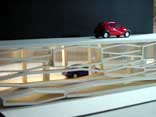 |
The
project won the first prize in the Parking lot competition at Via Salaria, in Rome. head: Carmelo Baglivo architects: Luca Galofaro, Laura Negrini engineering: Stefania Manna project: 2001 |
|||
|
>
ARCHITETTURE |
||||
per partecipare alla rubrica architetture laboratorio
|
||||